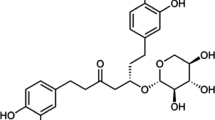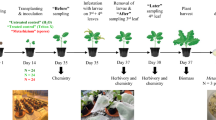Abstract
The effect of both caterpillar herbivory and artificial damage on phenylalanine ammonia lysase (PAL) activity of birch foliage was measured, using an intact cell assay. After artificial damage there was a small increase in PAL activity in damaged leaves but no change in adjacent undamaged ones. Insect grazing produced a larger increase in PAL activity, and the enzyme activity was also increased in adjacent undamaged leaves. Artificial damage increased the phenolic levels of the damaged leaves. Insect grazing caused a larger, longer-lasting increase in phenolic levels and also elevated phenolic levels in undamaged leaves. The possible role of these wound-induced biochemical changes in birch is discussed.
Similar content being viewed by others
References
Amrhein, N., Goedeke, K.H., andGerhardt, J. 1976. The estimation of phenylalanine ammonia lysase (PAL) activity in intact cells of higher plant tissue.Planta 131:33–40.
Bennett, S.E. 1965. Tannic acid as a repellant and toxin to alfalfa weevil.J. Econ. Entomol. 58:372–373.
Bergelson, J., Fowler, S., andHartley, S. 1986. The effects of foliage damage on casebearing moth larvae,Coleophora serratella, feeding on birch.Ecol. Entomol. 11:241–250.
Bernays, E.A. 1981. Plant tannins and insect herbivores: An appraisal.Ecol. Entomol. 6:353–360.
Bradford, M. 1976. A rapid and sensitive method for the quantitation of microgram quantities of protein utilizing the principle of protein-dye binding.Anal. Biochem. 72:248–254.
Conn, E.E. 1981. The Biochemistry of Plants, Vol. 7, Secondary Plant Products. Academic Press, London.
Dixon, R.A. 1986. The phytoalexin response: Elicitation, signalling, and control of gene expression.Biol. Rev. 61:239–291.
Hahlbrock, K., Lamb, C.J., Purwin, C., Ebel, J., Fautz, E., andSchaffer, E. 1981. Rapid response of suspension-cultured parsley cells to the elicitor fromPhytophthora megasperma var.sojae. Induction of the enzymes of the general phenylpropanoid metabolism.Plant Physiol 67:768–773.
Hartley, S.E., andLawton, J.L. 1987. Effects of different types of damage on the chemistry of birch foliage, and the responses of birch feeding insects.Oecologia (Berlin). 74:432–437.
Haukioja, E., andHahnimaki, S. 1985. Rapid wound-induced resistance in white birch (Betula pubesence) foligge to the geometridEpirrata autumnata: A comparison of trees and moths within and outside the outbreak range of the moth.Oecologia (Berlin). 65:223–228.
Haukioja, E., andNeuvonen, S. 1985. Induced long-term resistance of birch foliage against defoliators: Defensive or incidental?Ecology 66:1303–1308.
Haukioja, E., andNiemela, P. 1977. Retarded growth of a geometrid larva after damage to leaves of its host tree.Ann. Zool. Fenn. 14:48–52.
Karban, R., Adamchak, R., andSchnathorst, W.C. 1987. Induced resistance and interspecific composition between spider mites and a vascular wilt fungus.Science 235:678–680.
Lawton, J.H. 1987. Food shortage in the midst of apparent plenty?: The case for birch feeding insects, pp. 219–228,in H.W. Velthuis (ed.). Proceedings of the Third European Congress of Entomology. Nederlandse Entomologische Vereniging, Amsterdam.
Martin, J.S., andMartin, M.M. 1982. Tannin assays in ecological studies: Lack of correlation between phenolics, proanthocyanidins and protein-precipitating constituents in mature foliage of six oak species.Oecologia (Berlin) 54:205–211.
Mitra, R., Gross, R.D., andVarner, J.E. 1975. An intact tissue assay for enzymes that labilize C-H bonds.Anal. Biochem. 64:102–109.
Niemela, P., Aro, E.M., andHaukioja, E. 1979. Birch leaves as a resource for herbivores. Damage-induced increase in leaf phenols with trypsin-inhibiting effects.Rep. Kevo Subartic Res. Stat. 15:37–40.
Roehrig, N.E., and Capinera, J.L. 1983. Behavioral and developmental responses of range caterpillar larvae,Hemileuca oliviae, to condensed tannin.J. Insect Physiol. 29:901–906.
Ryan, C.A. 1974. Assay and biochemical properties of the proteinase inhibitor-inducing factor, a wound hormone.Plant Physiol. 54:328–332.
Shain, L., andHillis, W.E. 1972. Ethylene production inPinus radiata in response toSirex-Amylesterum attack.Phytopathology 62:1407–1409.
Shaw, C.G. 1985. In vitro responses of differentArmillaria taxato gallic acid, tannic acid and ethanol.Plant Pathol. 34:594–602.
Todd, G.W., Getahun, A., andCress, D.C. 1971. Resistance in barley to the greenbugSchizaphis granimum 1. Toxicity of phenolic and flavanoid compounds.Ann. Entomol. Soc. Am. 64:718–722.
Werder, J., andKern, H. 1985. Resistance of maize toHelminthosporium carbonum: Changes in host phenolics and their antifungal activity.J. Plant Dis. Prot. 92:477–484.
Wratten, S.D., Edwards, P.J., andDunn, I. 1984. Wound-induced changes in the palatability ofBetula pubescens andBetula pendula.Oecologia (Berlin) 61:372–375.
Author information
Authors and Affiliations
Rights and permissions
About this article
Cite this article
Hartley, S.E., Firn, R.D. Phenolic biosynthesis, leaf damage, and insect herbivory in birch (Betula pendula). J Chem Ecol 15, 275–283 (1989). https://doi.org/10.1007/BF02027789
Received:
Accepted:
Issue Date:
DOI: https://doi.org/10.1007/BF02027789




